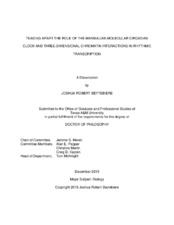| dc.contributor.advisor | Menet, Jerome S | |
| dc.creator | Beytebiere, Joshua Robert | |
| dc.date.accessioned | 2020-09-09T20:03:44Z | |
| dc.date.available | 2021-12-01T08:45:03Z | |
| dc.date.created | 2019-12 | |
| dc.date.issued | 2019-10-25 | |
| dc.date.submitted | December 2019 | |
| dc.identifier.uri | https://hdl.handle.net/1969.1/188983 | |
| dc.description.abstract | The mammalian molecular circadian clock is composed of a transcriptional-translational feedback loop. The positive arm of this loop is composed of the transcription factor CLOCK:BMAL1 which activates the transcription of their target genes Per and Cry. PER and CRY then feedback to inhibit their own transcription. The molecular circadian clock is also responsible for the activation of many clock-controlled genes. Recent data suggest that genes expressed in a circadian manner have little overlap among the tissues. The goal of this study is to determine the mechanisms by which the circadian clock can drive tissue-specific rhythmic gene expression. To identify the genes targeted by the circadian clock, we performed BMAL1 chromatin immunoprecipitation with massively parallel DNA sequencing (ChIP-seq) in the mouse liver, kidney, and heart. We determined the majority of binding to be tissue-specific, and this was largely accounted for by differences in the permissiveness of the chromatin, and binding with tissue-specific transcription factors.
The majority of genes targeted by BMAL1 were still transcribed arrhythmically, suggesting that BMAL1 binding alone is insufficient to drive rhythmic gene expression. To determine if enhancer-enhancer interactions play a role in rhythmic transcription, we performed POL II ChIAPET at ZT6 (middle of the day) and ZT18 (middle of the night). Our data show that rhythmically expressed BMAL1 targets exhibit day night differences in interactions between BMAL1 bound DHS and neighboring DHS. Our data suggest that BMAL1- mediated rhythmic transcription relies on the transcriptional activity of the BMAL1 bound DHS, neighboring DHS, and on the ability of BMAL1 to regulate the activity of neighboring DHS. To address the role of enhancer-enhancer interactions and the intrinsic activity of enhancers in coordinating rhythmic gene expression we developed a technique to measure the intrinsic activity of enhancers in vivo by cloning the enhancers into plasmids and delivering them to the liver via hydrodynamic tail vein injection. Our results indicate transfection of ten percent of liver cells and expression from the vector with our enhancer of interest suggesting that it likely will be a viable means to measure the intrinsic enhancer activity. | en |
| dc.format.mimetype | application/pdf | |
| dc.language.iso | en | |
| dc.subject | Circadian | en |
| dc.subject | Chromatin | en |
| dc.title | Teasing Apart the Role of the Mammalian Molecular Circadian Clock and Three-Dimensional Chromatin Interactions in Rhythmic Transcription | en |
| dc.type | Thesis | en |
| thesis.degree.department | Biology | en |
| thesis.degree.discipline | Biology | en |
| thesis.degree.grantor | Texas A&M University | en |
| thesis.degree.name | Doctor of Philosophy | en |
| thesis.degree.level | Doctoral | en |
| dc.contributor.committeeMember | Kaplan, Craig | |
| dc.contributor.committeeMember | Merlin, Christine | |
| dc.contributor.committeeMember | Pepper, Alan | |
| dc.type.material | text | en |
| dc.date.updated | 2020-09-09T20:03:44Z | |
| local.embargo.terms | 2021-12-01 | |
| local.etdauthor.orcid | 0000-0002-0022-1263 | |


